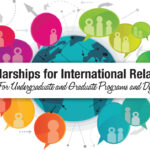Unveiling the Past: My Journey Through the History of Scholarships
I remember when I first applied for scholarships. The sheer number of them, the different criteria – it felt like navigating a giant, sparkling maze. There were scholarships for good grades, for specific majors, for volunteering, even for writing an essay about your favorite superhero! It was amazing, but also, it got me thinking: where did this all begin? Was there always a "scholarship"? Or did someone, somewhere, just decide one day, "Hey, let’s help people pay for school"?
That question gnawed at me, and one rainy afternoon, armed with a warm mug and a curious spirit, I decided to do some digging. What I found wasn’t just a list of dates and names; it was a sprawling, inspiring story that spans centuries and continents. It’s a tale of how the human desire to learn, and the human generosity to support that learning, has shaped education as we know it. Come along with me, and let me tell you what I discovered.
The Echoes of Ancient Wisdom: When "Scholarships" Weren’t Called Scholarships
My journey started far, far back, long before anyone even dreamed of a college application. We’re talking ancient times – think toga-wearing philosophers and grand temples. It turns out, the idea of supporting a bright mind wasn’t new even then.
Imagine ancient Greece, a hub of thought and debate. Guys like Plato ran academies, places where students would gather to learn philosophy, math, and rhetoric. Now, these weren’t like modern universities with tuition fees. But if a student was brilliant but couldn’t afford to live in Athens or dedicate all their time to study, wealthy patrons – kind of like ancient sponsors – would often step in. They’d provide lodging, food, or just general support so that promising young people could continue their education. It wasn’t a formal "scholarship application," but the spirit was there: recognizing potential and removing financial barriers.
The Romans also had a version of this, with emperors and rich families sometimes funding education for talented individuals, especially those who could serve the state later on. It wasn’t charity as much as an investment in talent. It made me realize that even without the fancy name, the core concept of giving someone a leg up in their education is deeply rooted in human history. It’s about nurturing the next generation of thinkers and leaders.
The Cloisters and Colleges: Medieval Beginnings
Fast forward a few hundred years, and we arrive in the medieval era. This is where things start to look a little more familiar, especially with the rise of the first proper universities in places like Bologna, Paris, Oxford, and Cambridge.
These early universities weren’t for everyone. They were largely religious institutions, and access was often limited to the wealthy or those connected to the church. However, even then, the need to support scholars became evident. Monasteries, which were major centers of learning at the time, would often take in young men (and sometimes women) who showed academic promise, providing them with food, lodging, and an education in exchange for their service or simply for the glory of God.
As universities grew, the concept of "endowments" started to take shape. Wealthy individuals, often nobles or church officials, would donate money or land to these universities. The income generated from these donations would then be used to support "poor scholars" – students who couldn’t otherwise afford to study. These were some of the very first structured "scholarships" in the sense that they were designated funds to support specific students. They often came with conditions, like studying certain subjects or having a good moral character, but they were a lifeline for many.
It’s pretty wild to think that when you hear about an Oxford college being founded by a medieval bishop, part of his vision might have been to create a lasting fund to ensure bright but needy students could always attend. It shows a foresight that I find truly inspiring.
The Renaissance and Beyond: Expanding Horizons
The Renaissance, a period of rebirth in art, science, and learning, saw an expansion of these ideas. As society became more complex and less solely focused on the church, wealthy merchants, philanthropists, and even kings started to establish funds for education.
This wasn’t just about religious study anymore. There was a growing interest in classical literature, sciences, and law. These new patrons saw the value in educating a broader range of people, not just for the church, but for the state and for commerce. Sometimes, these scholarships were for specific families or regions, a way for the wealthy to give back to their communities or ensure their lineage had educated members.
I learned about figures like Lady Margaret Beaufort, mother of King Henry VII, who established two colleges at Cambridge University (Christ’s College and St John’s College) and made provisions for scholars to be supported. Her contributions, among many others, solidified the idea that education was a worthy cause for substantial, lasting financial support. It wasn’t just a handout; it was an investment in the future.
The Industrial Age and the Rise of Formal Philanthropy
As we move into the 18th and 19th centuries, the world was changing rapidly with the Industrial Revolution. New industries meant new skills were needed, and education became even more crucial for social mobility and national progress. This era saw the birth of more formalized philanthropic organizations and the growth of public education systems.
It was during this time that many of the major charitable foundations we know today began to take root. Industrialists and entrepreneurs, who had amassed vast fortunes, often turned their attention to philanthropy later in life. They established trusts and foundations with the explicit purpose of funding education, health, and social welfare.
Think of people like George Peabody, an American businessman who funded education extensively in both the U.S. and the UK. Or the Carnegie family, whose foundations still provide immense support for education and research. These individuals weren’t just giving money; they were setting up systems to ensure that scholarships and educational grants could be distributed in a more organized, systematic way. This is where the concept of a "scholarship committee" and formal application processes really started to take shape. It was less about a single patron choosing a student and more about a structured process.
This period fascinates me because it’s where the modern scholarship model really starts to crystallize. It moved from informal support to structured programs designed to address societal needs and promote widespread access to learning.
The 20th Century: A Scholarship Boom
The 20th century, especially after the two World Wars, brought about massive shifts in education and scholarship. Governments began to play a much larger role in funding higher education, recognizing its importance for national prosperity and global competitiveness.
In the United States, a monumental piece of legislation, the GI Bill (officially the Servicemen’s Readjustment Act of 1944), completely transformed access to higher education. While not a traditional "scholarship" in the sense of merit or need-based, it provided returning WWII veterans with funds for tuition, books, and living expenses. Millions of veterans went to college, trade school, or started businesses, profoundly changing the American landscape and demonstrating the power of widespread educational access. It showed what was possible when a nation truly invested in its people’s education.
Beyond government initiatives, corporate scholarships became more common. Companies realized that investing in education could also be a way to cultivate future talent or give back to the communities where they operated. Universities themselves also expanded their own scholarship programs, often fueled by alumni donations and endowments that had grown over centuries.
This century also saw the rise of scholarships for specific groups: women, minorities, students pursuing niche fields, athletes, artists – the list goes on. The understanding grew that "talent" wasn’t limited to a narrow demographic, and that diverse perspectives enriched society. It was a huge step towards making education accessible to everyone, not just a select few.
The Modern Scholarship Landscape: Digital Age and Global Reach
And that brings us to today. The scholarship landscape is more diverse and accessible than ever before. Thanks to the internet, information about scholarships is at our fingertips. Websites, databases, and university portals make it easier to find opportunities that match almost any background or aspiration.
We have scholarships for academic excellence, for financial need, for leadership, for community service, for specific talents in music or sports, for students from particular regions, for those pursuing specific career paths, and even for things as unique as being left-handed or having a specific last name!
The spirit of those ancient patrons and medieval benefactors lives on, but it’s been amplified a million times over. Now, a small local community group might offer a scholarship for a graduating senior, while massive international foundations fund scholars from across the globe.
My Takeaway: More Than Just Money
My journey through the history of scholarships wasn’t just about facts and figures. It was about realizing that the desire to learn and the generosity to support that learning are timeless human traits. Every scholarship, no matter how big or small, carries with it a legacy of belief in potential, a hope for a brighter future, and a commitment to breaking down barriers.
When I applied for my scholarships, I was focused on the immediate need – paying for my education. But looking back, I now see that I was stepping into a tradition that stretches back thousands of years. I was becoming part of a continuous story of human endeavor and compassion.
So, the next time you hear about a scholarship, or if you’re ever lucky enough to receive one, remember its incredible history. It’s not just money for school; it’s a bridge built by countless hands across generations, connecting dreams to reality, and ensuring that the pursuit of knowledge remains an open path for all who dare to walk it. And that, I think, is a story truly worth telling.


